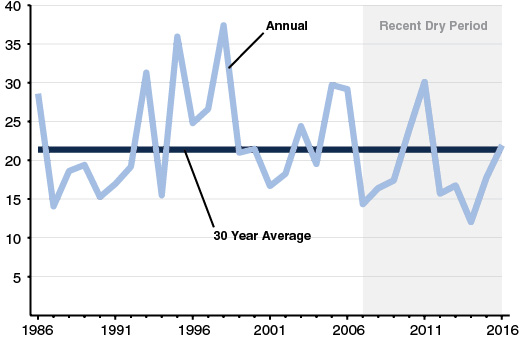With a state as big, as populous, and as complex as California, it would be impossible to quickly summarize how its economy or state budget works. The purpose of Cal Facts is more modest. By providing various "snapshot" pieces of information, we hope to provide the reader with a broad overview of public finance and program trends in the state.
Cal Facts consists of a series of charts and tables which address questions frequently asked of our office. We hope the reader will find it to be a handy and helpful document.
—Mac Taylor, Legislative Analyst
December 5, 2016
State Experiencing Multiyear Dry Period
Statewide Precipitation in Inches

- Precipitation has been at or below average for nine of the last ten years, with only one particularly wet year. The years 2012 through 2015 are the driest consecutive four-year stretch since the state started keeping records in 1896.
- This lack of precipitation has caused drought conditions around the state. Drought effects have included fallowed farm fields, groundwater depletion from increased pumping, dry residential wells, degraded habitats for fish and wildlife, and high rates of tree mortality in the state’s forests.
- State drought responses have included temporary water conservation requirements, emergency assistance (such as drinking water and fish rescues), and long-term projects to increase future water supplies.
Acres Burned by Wildfire Vary Over Time
(Acres In Thousands)

- The number of acres burned by wildfire in California varies significantly each year based on the number and size of wildfires. Weather, forest health, fire history, human activity, preventative measures, and response times all influence wildfire occurrences and severity.
- The threat of wildfire varies throughout the state. Communities that face the highest risk of losing lives or homes to wildfire include the populated areas around the coastal and interior ranges of Southern California, the hillsides surrounding the San Francisco Bay, and the foothills of the Sierra Nevada.
- The California Department of Forestry and Fire Protection is responsible for wildland fire protection on more than 31 million acres of mostly privately owned lands, referred to as State Responsibility Area. Local and federal firefighting agencies are responsible for the rest of the state.
Electricity Comes From Various Sources

- About two-thirds of California’s electricity comes from natural gas and renewable sources. California uses a greater share of natural gas and renewables (excluding large hydroelectric), and less coal and nuclear, than the national average.
- The percentage of renewable resources almost doubled from 2009 to 2015, largely driven by increases in wind and solar. Under state law, at least 33 percent of retail electricity must come from renewable sources by 2020 and 50 percent by 2030.
Recent Legislation Requires More Greenhouse Gas Reductions by 2030
MMtCO2e

- The Global Warming Solutions Act of 2006, commonly referred to as AB 32, established a target of reducing greenhouse gas (GHG) emissions statewide to 1990 levels by 2020.
- The state developed a wide variety of regulations and programs intended to help meet the 2020 target, including a cap-and-trade program and a requirement to produce 33 percent of electricity from renewable sources. Under these policies, the Air Resources Board (ARB) projects emissions will be below the AB 32 target in 2020.
- Chapter 249 of 2016 (SB 32, Pavley) established the target of reducing GHG emissions to 40 percent below 1990 levels by 2030. At the time of this report, ARB is developing a plan to achieve the new 2030 target.

